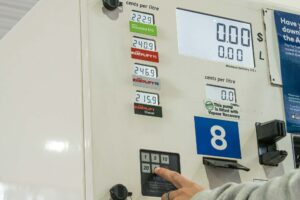One of the main arguments proffered by the owners of Australia’s fossil fuel generation fleet against the renewable energy target has been the massive over-capacity on the country’s main National Electricity Market.
Last year, AGL Energy estimated this overcapacity to be around 9,000MW. The arguments put forward in the submissions to the RET Review have said putting more renewables into the market is counter-productive. Not only will it reduce wholesale electricity prices – and therefore revenues for the coal and gas incumbents – but it is likely to force existing plant to retire earlier than might have been planned.
But whose fault is this overcapacity? The implication from the submissions is that it is the fault of the RET, and the build up of renewables.
But check out this graphic presented by EnergyAustralia retail chief Adrian Merrick at a recent energy conference hosted by UBS. It shows how much capacity has been added in the last five years.
Wind energy accounts for a little more than one quarter, and there has been a small amount of hydro. Around 70 per cent of increased capacity has come from coal, combined cycle gas plants and peaking gas plants.
Why did they do that? Pretty much for the same reason that the networks asked – and were granted – permission to build $45 billion of new and upgraded poles and wires: they assumed that demand would continue to rise, as it had done for the previous century.
But they ignored the warning signs on energy efficiency and the imminent rise of solar PV. As the red line shows, demand peaked five years ago and has been falling dramatically ever since.
The generators made the wrong call, and now they want the rollout of renewables stopped – or at least slowed down dramatically – to protect those dud investments.
This is the point that must be made clear. It is the only reason that generators have for wanting the RET stopped or diluted – to protect their assets. It has nothing to do with consumers.
EnergyAustralia built some of that capacity. It has already taken a $94 million write down on the value of its Tallawarra baseload gas plant in NSW, built in 2009. Other gas and brown coal generators have also been written down. Origin Energy has had to convert its newly built Darling Downs generator into a peaking plant, rather than a base load operator.
This is the third major myth around the renewable energy target that has been blown in the past week.
Other reasons proffered by the government and its urges to repeal the RET have also been dismissed, even by the federal government’s own hand-picked consultant. These include the contention that the renewable energy target cannot be met, an argument proffered by the major generators who are trying not to sign contracts with wind and solar farms. ACIL Allen – along with global energy supply giants such as General Electric and Vestas – says it can.
The RET also lowers prices for consumers, even if Prime Minister Tony Abbott continues to insist otherwise. The ACIL Allen report admitted to that as well.









